While it is doubtful that J-10 will go that fast (Mach 2.5), there is no evidence to support DSI is limited to below Mach 2.0. Your claim of such limit is only your opinion. On the other hand, we have this from 2005:
For DSI, pressure recovery coefficient is higher than 0.91 at M0.8. At M2.0, the coefficient decreases to 0.87. This suggests that the DSI being tested can reach Mach 2.0. Note that by this description, the pressure recovery ratio is higher than that of F-4D in the following graph, implying pressure recovery coefficient of DSI is better than the variable-geometry-inlet on F-4D. This rebuts your claim that variable-geometry-inlet is absolutely superior to DSI.
The
in 2011 is:
The important bit is that at Mach 2.05, the pressure recovery ratio approaches 0.9, which indicates two things. First, tests were conducted at Mach 2.05 which is already higher than Mach 2.0. Secondly, the pressure recovery ratio of 0.9 is higher than F-4D of 0.87. This improved ratio, combined with reduced weight of the intake, imply both improved engine performance and increase in thrust-to-weight ratio of the aircraft. In light of these evidences, your claim that DSI has an absolute limit of Mach 2.0 is extremely weak.
Also, fixed inlet is one type of inlet while DSI is another. Mixing the two terms to produce your own Frankenstien term isn't going to make your case any stronger. Even if we go by this Frankenstien term, F-22 with fixed inlets has a quoted top-speed of Mach 2.25, so your theory that fixed inlet is limited to below Mach 2.0 therefore DSI is limited below Mach 2.0 doesn't even work.
Finally, F-35 comparably low-speed has to do with the increased by-pass ratio of its engine. The increase of by-pass ratio increases thrust but reduces top-speed. There are many factors involved and not everything can be attributed to DSI. Your claim that F-35 cannot go at X speed therefore all aircraft with similar intakes cannot go at X speed is nothing but a grasp at straws to satisfy your own opinion.









